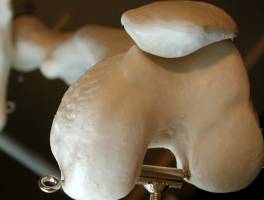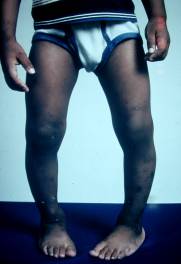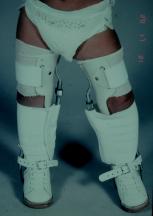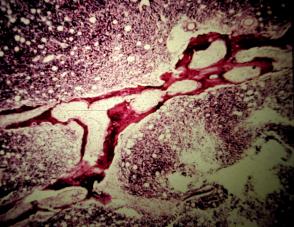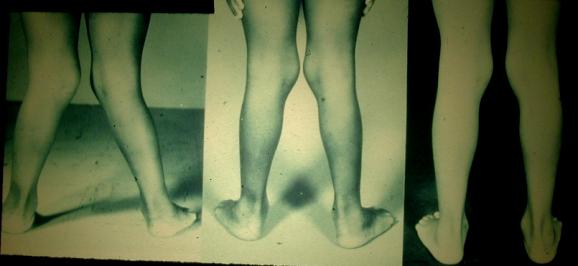Rotational Abnormalities
The most common reason for children to seek orthopaedic evaluation, except for trauma, is for suspected torsional or angular deformities of the lower extremities. Most are normal. Studies have show that measurements of torsion and angulation have wide ranges of normal. Values within 2 standard deviations of the mean are termed physiologic variations, those beyond are called deformities.
There is no convincing evidence that orthotic management of torsional or angular variations or deformities has any beneficial effect over simple observation of the natural history alone. Therefore, the management decision is between observation with parent education and surgery.
Function is frequently the family’s secondary concern to appearance. One study has shown that severe medial femoral torsion appears to adversely affect running, but a moderate amount of torsion does not. Marked genu valgum appears to adversely affect running performances as well, but this has not been documented.
Another concern about torsional or angular variations or deformities is the development of arthritis. No documentation to date proves a cause-and-effect relationship between such variations or deformities and arthritis of the hip or patellofemoral joint.
Because of the natural tendency for rotational deformities to remodel and improve with growth, surgical treatment is not indicated in children under 10-12 years of age.
The risk of complications from surgery is quite high. A 15% complication rate was found in a review of operative treatment for medial femoral torsion alone. In another study, a 13% incidence of peroneal nerve palsy was reported following proximal tibial rotational osteotomies if the fibula was not osteotomized.
A busy, full-time pediatric orthopaedist may find one or two torsional or angular variations or deformities per year that require surgery. The common operations for correction of torsion and angular deformity are much more frequently to correct the anteversion and coxa valga in cerebral palsy, the lateral tibial torsion with ankle valgus in myelodysplasia, and the angular deformities from old infection, partial physeal arrest, metabolic disorders, ischemia, ionizing irradiation, or genetic conditions.
Femoral Rotational Abnormalities
Femoral rotational osteotomies can be carried out proximally, in the mid-shaft or distally. The intertrochanteric region of the femur is the preferred site for proximal osteotomies. Here it is safe, heals rapidly and leaves an acceptable cosmetic scar. Simultaneous corrections of angulation and torsion can b e made with osteotomy at this level.
Closed mid-shaft IM rotational osteotomy of the femur is an alternative for the older adolescent in whom there is adequate IM shaft diameter. The utility of this operation in the immature child is limited both by its complexity and by the small but real risk of avascular necrosis of the femoral head related to the proximal insertion site for the nail.
Distal osteotomy in the supracondylar region gives the least acceptable scar, the highest risk of potential injury to growth plates, is more likely to leave residual angulation and is the farthest from the pathology, unless there is an associated patella-tracking problem.
Tibial Rotational Abnormalities
Indications for tibial rotational osteotomies are even narrower than for femoral rotational osteotomies. They are most often performed in conjunction with femoral osteotomies in the case of medial femoral torsion with lateral tibial torsion. Cosmesis is the prime indication.
Preoperatively, the angle of the transmalleolar axis and thigh-foot angle must be assessed to determine that the rotational problem is in the tibial and not in the foot.
Distal tibial rotational osteotomy is preferred for its accessibility, simplicity, safety, rapid healing and cosmetically acceptable scar. It is also versatile in cases where rotational abnormalities are accompanied by distal angular abnormalities. Proximal osteotomy has the disadvantages of potential injury to the peroneal nerve and the popliteal artery at its trifurcation, as well as damage to the tibial apophysis. There is also greater risk of compartment syndrome. Mid-shaft osteotomies have the disadvantages of potential for compartment syndrome and delayed union or nonunion.
Angular Abnormalities
Angular deformities predominantly occur in the tibia. It may occur in the frontal plane (varus/valgus), the sagittal plane (anterior/posterior), or both. Torsion may also be involved. It is important to understand the various physiologic and pathologic causes of angular deformities, the methods of evaluation, and the natural histories of the abnormalities to determine appropriate treatment.
Normal Development
– mild to moderate bowing of the lower extremities is common finding in infants and young children
– result of molding in utero.
– Bowed appearance is combination of external rotation of the hip (tight posterior capsule) and internal tibial torsion.
– Physiologic genu varum persists during 1st year of life and corrects spontaneously with walking
– Complete correction may require up to 36 months of ambulation
– Physiologic genu valgum may appear by 3-4 years of age (not result of torsional deformity
– Undergoes spontaneous correction with normal adult knee alignment of mid genu valgum, obtained by 5-8 years of age.
Normal development of knee alignment (Adapted from
Salenius & Vankka. JBJS Am 1975;57:259)
Genu Varum
– most often physiologic and operative treatment is rarely indicated
– evaluation consists of careful history and exam
– a lateral knee thrust during gait is uncommon and indicates pathology
– it can be difficult to differentiate radiographically between physiologic genu varum and Blount’s disease in children younger than 3 years
– The metaphyseal-diaphyseal angle aids in differentiation
o <9° indicates physiology genu varum
o >16° are predictive of tibia vara
o 9-16° are indeterminate
– follow infants and young children at 6-month intervals
Physiologic genu varum in a 3 year old that corrects by 4 years age.
Idiopathic Tibia Vara (Blount’s Disease)
– most common pathologic genu varum deformity
– abnormal growth of medial aspect of proximal tibial epiphysis resulting in progressive varus angulation
– appears to be secondary to growth suppression from increased compressive forces across medial aspect of knee
– may occur at any age in a growing child, classified by age
o Infantile (1-3 years)
o Juvenile (4-10 years) – much higher risk of recurrence
o Adolescent (11 and older)
– also classified by stage of progression (Langenskiold)
– if diagnosed early, may respond to bracing
|
If diagnosed early the patient may respond to bracing
If not corrected early, deformity can be severe, often requiring multiple surgeries.
Renal Osteodystrophy
– may manifest in children with end-stage renal disease
– physes show same pathologic changes found in tibia vara and SCFE, including disorganized endochondral ossification at physeal-metaphyseal junctions
– much more common to present with valgus because common in older children
o varus more likely when renal failure occurs at or younger than 3 years
– has same radiographic features as rickets (nutritional and Vit. D deficient)
o physeal cupping and widening at both distal femoral & proximal tibial physes
– treatment involves medical correction of disease, surgery is delayed until stabilization of disease (medical treatment, hemodialysis or transplant)
Rickets
– progressive genu varum is common in children with metabolic disorders such as hypophosphatemic or nutritional rickets
– vitamin D-resistant rickets
o X-linked
o results in defective bone mineralization
o usually bilateral symmetric genu varum
o usually short (being in 10th percentile)
o varus due to combination of bowing of distal femur and proximal tibia
o hematology studies show normal serum calcium and decreased phosphate values
– nutritional rickets
o child receiving an unusual diet from parents
o much less common given vit. D supplementation of milk
– radiographic features are widening of metaphyses, widening of physes and cup-shaped relationship of metaphysis and physis
– bowing is usually symmetric throughout femur and tibia
– marked osteopenia and cortical thinning are common
– medical treatment is important before orthopaedic intervention is considered
– spontaneous improvement may be seen in children younger than 5 years
– surgical treatment involves femoral and/or tibial osteotomies
– healing time is often twice normal
Genu Valgum
– most often physiologic and operative treatment is rarely indicated
– most common pathologic causes are posttraumatic and renal osteodystrophy
– evaluation consists of careful history and exam
– gat thighs, ligamentous laxity & flat feet can accentuate the appearance of knock-knee, making physiologic genu valgum appear more severe
– methods of assessment are femoro-tibial angle and intermalleolar distance
– indications for films are short stature, asymmetry, history of progression
– normal finding in children 2 to 6 years (max at 3 to 4 years)
– rarely causes symptoms or disability unless severe, causing knees to rum and child walks and runs with circumduction gait
– in older children or adolescents may lead to malalignment of quads resulting in patellar subluxation or dislocation
– major indication for surgery is persistent severe deformity (>15°) in girls age 11 and boys age 12, after this significant spontaneous improvement is unlikely
Genu Valgum after Fracture
– fractures of the proximal tibial metaphysis are relatively common and tend to occur most frequently in children between 3 and 6 years
– usually the result of direct injury to the lateral aspect of the extended knee
– most are nondisplaced, without angulation, but the distal fragment may angulate into a slight valgus deformity
– the most common sequelae are valgus deformity and overgrowth of the tibia (Cozen phenomenon)
– incidence appears to be approximately 50%
– theories include injury to lateral physis, inadequate reduction, asymmetric growth stimulation and tethering from intact fibula
– usually develops within 5 months of injury, reaches max at 1-2 years
– deformities of 15° or less usually remodel completely
Metabolic Disorders
– include vit. D-resistant rickets, nutritional rickets and renal osteodystrophy, the most common being renal osteodystrophy
– treatment is generally initiated after correction of underlying metabolic disorder to reduce likelihood of recurrence
Congenital Angulation Deformities of the Tibia & Fibula
Congenital angular deformities of the tibia and fibula are uncommon. Anterior and anterolateral angulation or bowing is the most common form and is usually associated with other congenital anomalies, such as congenital pseudarthrosis. Congenital posteromedial angulation is less common resolves spontaneously and is not associated with significant osseus pathology other than residual lower-extremity length inequality.
Anterolateral Bowing
– usually associated with significant pathologic disorders
o congenial pseudarthrosis
- exact cause unknown, 40-80% diagnosed with neurofibromatosis
- others fibrous dysplasia or no associated disorders
o congenital longitudinal deficiency of tibia (paraxial tibial hemimelia)
o congenital longitudinal deficiency of fibula (paraxial fibular hemimelia)
– natural history is fracture with pseudoarthrosis
– treatment is directed toward prevention of the fracture and pseudoarthrosis
o total-contact plastic orthosis, usually AFO – worn for years
o may delay or prevent fracture
– with growth and absence of fracture, bowing usually improves
– casting alone rarely results in healing, but is possible in late-onset fracture
– surgical goals include obtaining and maintaining union and limb length
– options include bone grafting +/- fixation, microvascular bone grafting, Ilizarov ex-fix methods and amputation
Posteromedial Bowing
– cause is unknown
– has 3 associated problems
o angular deformity
o calcaneovalgus foot
o lower-extremity length inequality
– deformity usually at junction of middle and distal thirds of shaft
– no increased incidence of other congenital anomalies
– angulation can vary from 25-65°
– resolves with growth, especially during first 3 years of life, posterior more quickly than medial
– associated shortening of tibia & fibula persists and often progresses
– management usually consists of stretching of hyperdorsiflexed foot for anterior compartment contractures, casting may be necessary
– typically only two operative procedures utilized for this disorder
o osteotomy to correct severe or persistent angulation
- if persists after 3 to 4 years
- bone healing rarely a problem
o equalization of lower-extremity length inequality
| Classification of Genu Varum or Bowleg Deformities of the Lower Extremities Physiologic genu varum
Pathologic genu varum Tibia vara (Blount’s disease) – Infantile – Juvenile – Adolescent Focal fibrocartilaginous dysplasia Physeal injury – Trauma – Infection – Tumor Metabolic disorders – Vitamin D deficiency (nutritional rickets) – Vitamin D-resistant rickets – Hypophosphatasia – Renal osteodystrophy Skeletal dysplasia – Metaphyseal chondrodysplasia – Achondroplasia – Enchondromatosis – Osteogenesis Imperfecta
|
Classification of Genu Valgum or Knock-knee Deformities of the Lower Extremities Physiologic genu varum
Pathologic genu varum Trauma – Physeal injury – Genu valgum following fx proximal tibial metaphysis – Malunions Infection – Physeal damage Tumor – Physeal involvement Metabolic disorders – Vitamin D deficiency (nutritional rickets) – Vitamin D-resistant rickets – Renal osteodystrophy Skeletal dysplasia – Multiple epiphyseal dysplasia – Pseudoachondrodysplasia – Kneist syndrome Congenital abnormalities – Congenital dislocation of the patella Neuromuscular disorders – Cerebral palsy – Myelodysplasia |
| Surgical Options for Genu Varum DeformitiesDistal femurValgus osteotomy
– Closing wedge – Opening wedge – Callotasis Lateral hemiepiphyseal stapling Lateral hemieipphysiodesis Proximal tibia Valgus osteotomy – Closing wedge – Opening wedge – Dome – Oblique – Callotasis Lateral hemiepiphyseal stapling Lateral hemieipphysiodesis |
Surgical Options for Genu Valgum DeformitiesDistal femurVarus osteotomy
– Closing wedge – Opening wedge – Callotasis Medial hemiepiphyseal stapling Medial hemieipphysiodesis Proximal tibia Varus osteotomy – Closing wedge – Opening wedge – Dome – Oblique – Callotasis Medial hemiepiphyseal stapling Medial hemieipphysiodesis |



